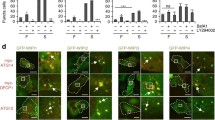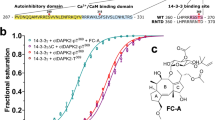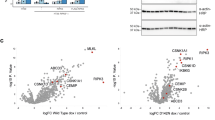Abstract
DAP-kinase (DAPK) is a Ca2+/calmodulin regulated Ser/Thr kinase that activates a diverse range of cellular activities. It is subject to multiple layers of regulation involving both intramolecular signaling, and interactions with additional proteins, including other kinases and phosphatases. Its protein stability is modulated by at least three distinct ubiquitin-dependent systems. Like many kinases, DAPK participates in several signaling cascades, by phosphorylating additional kinases such as ZIP-kinase and protein kinase D (PKD), or Pin1, a phospho-directed peptidyl-prolyl isomerase that regulates the function of many phosphorylated proteins. Other substrate targets have more direct cellular effects; for example, phosphorylation of the myosin II regulatory chain and tropomyosin mediate some of DAPK’s cytoskeletal functions, including membrane blebbing during cell death and cell motility. DAPK induces distinct death pathways of apoptosis, autophagy and programmed necrosis. Among the substrates implicated in these processes, phosphorylation of PKD, Beclin 1, and the NMDA receptor has been reported. Interestingly, not all cellular effects are mediated by DAPK’s catalytic activity. For example, by virtue of protein–protein interactions alone, DAPK activates pyruvate kinase isoform M2, the microtubule affinity regulating kinases and inflammasome protein NLRP3, to promote glycolysis, influence microtubule dynamics, and enhance interleukin-1β production, respectively. In addition, a number of other substrates and interacting proteins have been identified, the physiological significance of which has not yet been established. All of these substrates, effectors and regulators together comprise the DAPK interactome. By presenting the components of the interactome network, this review will clarify both the mechanisms by which DAPK function is regulated, and by which it mediates its various cellular effects.



Similar content being viewed by others
References
Bialik S, Kimchi A (2004) DAP-kinase as a target for drug design in cancer and diseases associated with accelerated cell death. Semin Cancer Biol 14(4):283–294. doi:10.1016/j.semcancer.2004.04.008
Cohen O, Feinstein E, Kimchi A (1997) DAP-kinase is a Ca2+/calmodulin-dependent, cytoskeletal-associated protein kinase, with cell death-inducing functions that depend on its catalytic activity. EMBO J 16(5):998–1008. doi:10.1093/emboj/16.5.998
de Diego I, Kuper J, Bakalova N, Kursula P, Wilmanns M (2010) Molecular basis of the death-associated protein kinase-calcium/calmodulin regulator complex. Sci Signal 3(106):ra6. doi:10.1126/scisignal.2000552
Shohat G, Spivak-Kroizman T, Cohen O, Bialik S, Shani G, Berrisi H, Eisenstein M, Kimchi A (2001) The pro-apoptotic function of death-associated protein kinase is controlled by a unique inhibitory autophosphorylation-based mechanism. J Biol Chem 276(50):47460–47467. doi:10.1074/jbc.M105133200
Guenebeaud C, Goldschneider D, Castets M, Guix C, Chazot G, Delloye-Bourgeois C, Eisenberg-Lerner A, Shohat G, Zhang M, Laudet V, Kimchi A, Bernet A, Mehlen P (2010) The dependence receptor UNC5H2/B triggers apoptosis via PP2A-mediated dephosphorylation of DAP kinase. Mol Cell 40(6):863–876. doi:10.1016/j.molcel.2010.11.021
Jin Y, Blue EK, Gallagher PJ (2006) Control of death-associated protein kinase (DAPK) activity by phosphorylation and proteasomal degradation. J Biol Chem 281(51):39033–39040. doi:10.1074/jbc.M605097200
Gozuacik D, Bialik S, Raveh T, Mitou G, Shohat G, Sabanay H, Mizushima N, Yoshimori T, Kimchi A (2008) DAP-kinase is a mediator of endoplasmic reticulum stress-induced caspase activation and autophagic cell death. Cell Death Differ 15(12):1875–1886. doi:10.1038/cdd.2008.121
Shamloo M, Soriano L, Wieloch T, Nikolich K, Urfer R, Oksenberg D (2005) Death-associated protein kinase is activated by dephosphorylation in response to cerebral ischemia. J Biol Chem 280:42290–42299. doi:10.1074/jbc.M505804200
Luo XJ, Li W, Yang LF, Yu XF, Xiao LB, Tang M, Dong X, Deng QP, Bode AM, Liu JK, Cao Y (2011) DAPK1 mediates the G1 phase arrest in human nasopharyngeal carcinoma cells induced by grifolin, a potential antitumor natural product. Eur J Pharmacol 670(2–3):427–434. doi:10.1016/j.ejphar.2011.08.026
Ling YH, Aracil M, Zou Y, Yuan Z, Lu B, Jimeno J, Cuervo AM, Perez-Soler R (2011) PM02734 (elisidepsin) induces caspase-independent cell death associated with features of autophagy, inhibition of the Akt/mTOR signaling pathway, and activation of death-associated protein kinase. Clin Cancer Res 17(16):5353–5366. doi:10.1158/1078-0432.CCR-10-1948
Jiang Q, Li F, Shi K, Yang Y, Xu C (2012) Sodium selenite-induced activation of DAPK promotes autophagy in human leukemia HL60 cells. BMB Rep 45(3):194–199. doi:10.5483/BMBRep.2012.45.3.194
Widau RC, Jin Y, Dixon SA, Wadzinski BE, Gallagher PJ (2010) Protein phosphatase 2A (PP2A) holoenzymes regulate death-associated protein kinase (DAPK) in ceramide-induced anoikis. J Biol Chem 285(18):13827–13838. doi:10.1074/jbc.M109.085076
Llambi F, Lourenco FC, Gozuacik D, Guix C, Pays L, Del Rio G, Kimchi A, Mehlen P (2005) The dependence receptor UNC5H2 mediates apoptosis through DAP-kinase. EMBO J 24(6):1192–1201. doi:10.1038/sj.emboj.7600584
Marin I, van Egmond WN, van Haastert PJ (2008) The Roco protein family: a functional perspective. FASEB J 22(9):3103–3110. doi:10.1096/fj.08-111310
Klein CL, Rovelli G, Springer W, Schall C, Gasser T, Kahle PJ (2009) Homo- and heterodimerization of ROCO kinases: LRRK2 kinase inhibition by the LRRK2 ROCO fragment. J Neurochem 111(3):703–715. doi:10.1111/j.1471-4159.2009.06358.x
Carlessi R, Levin-Salomon V, Ciprut S, Bialik S, Berissi H, Albeck S, Peleg Y, Kimchi A (2011) GTP binding to the ROC domain of DAP-kinase regulates its function through intramolecular signalling. EMBO Rep 12(9):917–923. doi:10.1038/embor.2011.126
Chen CH, Wang WJ, Kuo JC, Tsai HC, Lin JR, Chang ZF, Chen RH (2005) Bidirectional signals transduced by DAPK–ERK interaction promote the apoptotic effect of DAPK. EMBO J 24(2):294–304. doi:10.1038/sj.emboj.7600510
Anjum R, Roux PP, Ballif BA, Gygi SP, Blenis J (2005) The tumor suppressor DAP kinase is a target of RSK-mediated survival signaling. Curr Biol 15(19):1762–1767. doi:10.1016/j.cub.2005.08.050
Bajbouj K, Poehlmann A, Kuester D, Drewes T, Haase K, Hartig R, Teller A, Kliche S, Walluscheck D, Ivanovska J, Chakilam S, Ulitzsch A, Bommhardt U, Leverkus M, Roessner A, Schneider-Stock R (2009) Identification of phosphorylated p38 as a novel DAPK-interacting partner during TNFalpha-induced apoptosis in colorectal tumor cells. Am J Pathol 175(2):557–570. doi:10.2353/ajpath.2009.080853
Wang WJ, Kuo JC, Ku W, Lee YR, Lin FC, Chang YL, Lin YM, Chen CH, Huang YP, Chiang MJ, Yeh SW, Wu PR, Shen CH, Wu CT, Chen RH (2007) The tumor suppressor DAPK is reciprocally regulated by tyrosine kinase Src and phosphatase LAR. Mol Cell 27(5):701–716. doi:10.1016/j.molcel.2007.06.037
Citri A, Harari D, Shohat G, Ramakrishnan P, Gan J, Lavi S, Eisenstein M, Kimchi A, Wallach D, Pietrokovski S, Yarden Y (2006) Hsp90 recognizes a common surface on client kinases. J Biol Chem 281:14361–14369. doi:10.1074/jbc.M512613200
Jin Y, Blue EK, Dixon S, Shao Z, Gallagher PJ (2002) A death-associated protein kinase (DAPK)-interacting protein, DIP-1, is an E3 ubiquitin ligase that promotes tumor necrosis factor-induced apoptosis and regulates the cellular levels of DAPK. J Biol Chem 277(49):46980–46986. doi:10.1074/jbc.M208585200
Zhang L, Nephew KP, Gallagher PJ (2007) Regulation of death-associated protein kinase. Stabilization by HSP90 heterocomplexes. J Biol Chem 282(16):11795–11804. doi:10.1074/jbc.M610430200
Capoccia BJ, Jin RU, Kong YY, Peek RM Jr, Fassan M, Rugge M, Mills JC (2013) The ubiquitin ligase Mindbomb 1 coordinates gastrointestinal secretory cell maturation. J Clin Invest 123(4):1475–1491. doi:10.1172/JCI65703
Koo BK, Lim HS, Song R, Yoon MJ, Yoon KJ, Moon JS, Kim YW, Kwon MC, Yoo KW, Kong MP, Lee J, Chitnis AB, Kim CH, Kong YY (2005) Mind bomb 1 is essential for generating functional notch ligands to activate notch. Development 132(15):3459–3470. doi:10.1242/dev.01922
Lee YR, Yuan WC, Ho HC, Chen CH, Shih HM, Chen RH (2010) The Cullin 3 substrate adaptor KLHL20 mediates DAPK ubiquitination to control interferon responses. EMBO J 29(10):1748–1761. doi:10.1038/emboj.2010.62
Lai M-Z, Chen R-H (2013) Regulation of inflammation by DAPK. Apoptosis. doi:10.1007/s10495-013-0933-4
Bialik S, Bresnick AR, Kimchi A (2004) DAP-kinase-mediated morphological changes are localization dependent and involve myosin-II phosphorylation. Cell Death Differ 11(6):631–644. doi:10.1038/sj.cdd.4401386
Houle F, Poirier A, Dumaresq J, Huot J (2007) DAP kinase mediates the phosphorylation of tropomyosin-1 downstream of the ERK pathway, which regulates the formation of stress fibers in response to oxidative stress. J Cell Sci 120(20):3666–3677. doi:10.1242/jcs.003251
Zalckvar E, Berissi H, Mizrachy L, Idelchuk Y, Koren I, Eisenstein M, Sabanay H, Pinkas-Kramarski R, Kimchi A (2009) DAP-kinase-mediated phosphorylation on the BH3 domain of beclin 1 promotes dissociation of beclin 1 from Bcl-XL and induction of autophagy. EMBO Rep 10(3):285–292. doi:10.1038/embor.2008.246
Eisenberg-Lerner A, Kimchi A (2011) PKD is a kinase of Vps34 that mediates ROS-induced autophagy downstream of DAPk. Cell Death Differ 19(5):788–797. doi:10.1038/cdd.2011.149
Bialik S, Kimchi A (2006) The death-associated protein kinases: structure, function and beyond. Annu Rev Biochem 75:189–210. doi:10.1146/annurev.biochem.75.103004.142615
Wang WJ, Kuo JC, Yao CC, Chen RH (2002) DAP-kinase induces apoptosis by suppressing integrin activity and disrupting matrix survival signals. J Cell Biol 159(1):169–179. doi:10.1083/jcb.200204050
Raveh T, Droguett G, Horwitz MS, DePinho RA, Kimchi A (2001) DAP kinase activates a p19ARF/p53-mediated apoptotic checkpoint to suppress oncogenic transformation. Nat Cell Biol 3(1):1–7. doi:10.1038/35050500
Craig AL, Chrystal JA, Fraser JA, Sphyris N, Lin Y, Harrison BJ, Scott MT, Dornreiter I, Hupp TR (2007) The MDM2 ubiquitination signal in the DNA-binding domain of p53 forms a docking site for calcium calmodulin kinase superfamily members. Mol Cell Biol 27(9):3542–3555. doi:10.1128/MCB.01595-06
Tu W, Xu X, Peng L, Zhong X, Zhang W, Soundarapandian MM, Belal C, Wang M, Jia N, Zhang W, Lew F, Chan SL, Chen Y, Lu Y (2010) DAPK1 interaction with NMDA receptor NR2B subunits mediates brain damage in stroke. Cell 140(2):222–234. doi:10.1016/j.cell.2009.12.055
Eisenberg-Lerner A, Kimchi A (2007) DAP-kinase regulates JNK signaling by binding and activating protein kinase D under oxidative stress. Cell Death Differ 14:1908–1915. doi:10.1038/sj.cdd.4402212
Dirkx E, Schwenk RW, Coumans WA, Hoebers N, Angin Y, Viollet B, Bonen A, van Eys GJ, Glatz JF, Luiken JJ (2012) Protein kinase D1 is essential for contraction-induced glucose uptake but is not involved in fatty acid uptake into cardiomyocytes. J Biol Chem 287(8):5871–5881. doi:10.1074/jbc.M111.281881
Schumacher AM, Schavocky JP, Velentza AV, Mirzoeva S, Watterson DM (2004) A calmodulin-regulated protein kinase linked to neuron survival is a substrate for the calmodulin-regulated death-associated protein kinase. Biochemistry 43(25):8116–8124. doi:10.1021/bi049589v
Shani G, Marash L, Gozuacik D, Bialik S, Teitelbaum L, Shohat G, Kimchi A (2004) Death-associated protein kinase phosphorylates ZIP kinase, forming a unique kinase hierarchy to activate its cell death functions. Mol Cell Biol 24(19):8611–8626. doi:10.1128/MCB.24.19.8611-8626.2004
Zimmermann M, Atmanene CD, Xu Q, Fouillen L, Van Dorsselaer A, Bonnet D, Marsol C, Hibert M, Sanglier-Cianferani S, Pigault C, McNamara LK, Watterson DM, Haiech J, Kilhoffer M-C (2010) Homodimerization of the death-associated protein kinase catalytic domain: development of a new small molecule fluorescent reporter. PLoS One 5(11):e14120. doi:10.1371/journal.pone.0014120
Graves PR, Winkfield KM, Haystead TA (2005) Regulation of zipper-interacting protein kinase activity in vitro and in vivo by multisite phosphorylation. J Biol Chem 280(10):9363–9374. doi:10.1074/jbc.M412538200
Usui T, Okada M, Yamawaki H (2013) Zipper interacting protein kinase (ZIPK): function and signaling. Apoptosis. doi:10.1007/s10495-013-0934-3
Mukhopadhyay R, Jia J, Arif A, Ray PS, Fox PL (2009) The GAIT system: a gatekeeper of inflammatory gene expression. Trends Biochem Sci 34(7):324–331. doi:10.1016/j.tibs.2009.03.004
Schumacher A, Velentza A, Watterson D, Dresios J (2006) Death-associated protein kinase phosphorylates mammalian ribosomal protein s6 and reduces protein synthesis. Biochemistry 45(45):13614–13621. doi:10.1021/bi060413y
Stevens C, Lin Y, Harrison B, Burch L, Ridgway RA, Sansom O, Hupp T (2009) Peptide combinatorial libraries identify TSC2 as a death-associated protein kinase (DAPK) death domain-binding protein and reveal a stimulatory role for DAPK in mTORC1 signaling. J Biol Chem 284(1):334–344. doi:10.1074/jbc.M805165200
Meyuhas O (2008) Physiological roles of ribosomal protein S6: one of its kind. Int Rev Cell Mol Biol 268:1–37. doi:10.1016/S1937-6448(08)00801-0
Khalaileh A, Dreazen A, Khatib A, Apel R, Swisa A, Kidess-Bassir N, Maitra A, Meyuhas O, Dor Y, Zamir G (2013) Phosphorylation of ribosomal protein S6 attenuates DNA damage and tumor suppression during development of pancreatic cancer. Cancer Res 73(6):1811–1820. doi:10.1158/0008-5472.CAN-12-2014
Bialik S, Berissi H, Kimchi A (2008) A high throughput proteomics screen identifies novel substrates of death-associated protein kinase. Mol Cell Proteomics 7(6):1089–1098. doi:10.1074/mcp.M700579-MCP200
Lee TH, Chen C-H, Suizu F, Huang P, Schiene-Fischer C, Daum S, Zhang YJ, Goate A, Chen R-H, Zhou XZ, Lu KP (2011) Death-associated protein kinase 1 phosphorylates Pin1 and inhibits its prolyl isomerase activity and cellular function. Mol Cell 42(2):147–159. doi:10.1016/j.molcel.2011.03.005
Tian JH, Das S, Sheng ZH (2003) Ca2+-dependent phosphorylation of syntaxin-1A by the death-associated protein (DAP) kinase regulates its interaction with Munc18. J Biol Chem 278(28):26265–26274. doi:10.1074/jbc.M300492200
Pelkmans L, Fava E, Grabner H, Hannus M, Habermann B, Krausz E, Zerial M (2005) Genome-wide analysis of human kinases in clathrin- and caveolae/raft-mediated endocytosis. Nature 436(7047):78–86. doi:10.1038/nature03571
Levin-Salomon V, Bialik S, Kimchi A (2013) DAP-kinase and autophagy. Apoptosis. doi:10.1007/s10495-013-0918-3
Snyder M, He W, Zhang JJ (2005) The DNA replication factor MCM5 is essential for Stat1-mediated transcriptional activation. Proc Natl Acad Sci USA 102(41):14539–14544. doi:10.1073/pnas.0507479102
Gonzalez S, Klatt P, Delgado S, Conde E, Lopez-Rios F, Sanchez-Cespedes M, Mendez J, Antequera F, Serrano M (2006) Oncogenic activity of Cdc6 through repression of the INK4/ARF locus. Nature 440(7084):702–706. doi:10.1038/nature04585
Wu PR, Tsai PI, Chen GC, Chou HJ, Huang YP, Chen YH, Lin MY, Kimchi A, Chien CT, Chen RH (2011) DAPK activates MARK1/2 to regulate microtubule assembly, neuronal differentiation, and tau toxicity. Cell Death Differ 18(9):1507–1520. doi:10.1038/cdd.2011.2
Matenia D, Mandelkow E-M (2009) The tau of MARK: a polarized view of the cytoskeleton. Trends Biochem Sci 34(7):332–342. doi:10.1016/j.tibs.2009.03.008
Harrison B, Kraus M, Burch L, Stevens C, Craig A, Gordon-Weeks P, Hupp T (2008) DAPK-1 binding to a linear peptide motif in MAP1B stimulates autophagy and membrane blebbing. J Biol Chem 283:9999–10014. doi:10.1074/jbc.M706040200
Mor I, Carlessi R, Ast T, Feinstein E, Kimchi A (2011) Death-associated protein kinase increases glycolytic rate through binding and activation of pyruvate kinase. Oncogene 31(6):683–693. doi:10.1038/onc.2011.264
Luo W, Semenza GL (2012) Emerging roles of PKM2 in cell metabolism and cancer progression. Trends Endocrinol Metab 23(11):560–566. doi:10.1016/j.tem.2012.06.010
Yang W, Zheng Y, Xia Y, Ji H, Chen X, Guo F, Lyssiotis CA, Aldape K, Cantley LC, Lu Z (2012) ERK1/2-dependent phosphorylation and nuclear translocation of PKM2 promotes the Warburg effect. Nat Cell Biol 14 (12):1295–1304. http://www.nature.com/ncb/journal/v14/n12/abs/ncb2629.html#supplementary-information
Chuang YT, Lin YC, Lin KH, Chou TF, Kuo WC, Yang KT, Wu PR, Chen RH, Kimchi A, Lai MZ (2010) Tumor suppressor death-associated protein kinase is required for full IL-1{beta} production. Blood 17(3):960–970. doi:10.1182/blood-2010-08-303115
Chakilam S, Gandesiri M, Rau TT, Agaimy A, Vijayalakshmi M, Ivanovska J, Wirtz RM, Schulze-Luehrmann J, Benderska N, Wittkopf N, Chellappan A, Ruemmele P, Vieth M, Rave-Frank M, Christiansen H, Hartmann A, Neufert C, Atreya R, Becker C, Steinberg P, Schneider-Stock R (2013) Death-associated protein kinase controls STAT3 activity in intestinal epithelial cells. Am J Pathol 182(3):1005–1020. doi:10.1016/j.ajpath.2012.11.026
Kuo J, Wang W, Yao C, Wu P, Chen R (2006) The tumor suppressor DAPK inhibits cell motility by blocking the integrin-mediated polarity pathway. J Cell Biol 172(4):619–631. doi:10.1083/jcb.200505138
Chuang YT, Fang LW, Lin-Feng MH, Chen RH, Lai MZ (2008) The tumor suppressor death-associated protein kinase targets to TCR-stimulated NF-kappa B activation. J Immunol 180(5):3238–3249
Douglass J, Gunaratne R, Bradford D, Saeed F, Hoffert JD, Steinbach PJ, Knepper MA, Pisitkun T (2012) Identifying protein kinase target preferences using mass spectrometry. Am J Physiol Cell Physiol 303(7):C715–C727. doi:10.1152/ajpcell.00166.2012
Velentza AV, Schumacher AM, Weiss C, Egli M, Watterson DM (2001) A protein kinase associated with apoptosis and tumor suppression: structure, activity, and discovery of peptide substrates. J Biol Chem 276(42):38956–38965. doi:10.1074/jbc.M104273200
Maisse C, Rossin A, Cahuzac N, Paradisi A, Klein C, Haillot ML, Herincs Z, Mehlen P, Hueber AO (2008) Lipid raft localization and palmitoylation: identification of two requirements for cell death induction by the tumor suppressors UNC5H. Exp Cell Res 314(14):2544–2552. doi:10.1016/j.yexcr.2008.06.001
Mukhopadhyay R, Ray PS, Arif A, Brady AK, Kinter M, Fox PL (2008) DAPK-ZIPK-L13a axis constitutes a negative-feedback module regulating inflammatory gene expression. Mol Cell 32(3):371–382. doi:10.1016/j.molcel.2008.09.019
Rozengurt E (2011) Protein kinase D signaling: multiple biological functions in health and disease. Physiology (Bethesda) 26(1):23–33. doi:10.1152/physiol.00037.2010
Backer JM (2008) The regulation and function of Class III PI3Ks: novel roles for Vps34. Biochem J 410(1):1–17. doi:10.1042/BJ20071427
Lu KP, Zhou XZ (2007) The prolyl isomerase PIN1: a pivotal new twist in phosphorylation signalling and disease. Nat Rev Mol Cell Biol 8(11):904–916. doi:10.1038/nrm2261
Mizuno K (2013) Signaling mechanisms and functional roles of cofilin phosphorylation and dephosphorylation. Cell Signal 25(2):457–469. doi:10.1016/j.cellsig.2012.11.001
Ivanovska J, Tregubova A, Mahadevan V, Chakilam S, Gandesiri M, Benderska N, Ettle B, Hartmann A, Soder S, Ziesche E, Fischer T, Lautscham L, Fabry B, Segerer G, Gohla A, Schneider-Stock R (2013) Identification of DAPK as a scaffold protein for the LIMK/cofilin complex in TNF-induced apoptosis. Int J Biochem Cell Biol 45(8):1720–1729. doi:10.1016/j.biocel.2013.05.013
Spratley SJ, Bastea LI, Doppler H, Mizuno K, Storz P (2011) Protein kinase D regulates cofilin activity through p21-activated kinase 4. J Biol Chem 286(39):34254–34261. doi:10.1074/jbc.M111.259424
Acknowledgments
This work was supported by Grants from the Flight Attendants Medical Research Institute (FAMRI) and the European Research Council (ERC) FP7. AK is the incumbent of the Helena Rubinstein Chair of Cancer Research.
Author information
Authors and Affiliations
Corresponding author
Rights and permissions
About this article
Cite this article
Bialik, S., Kimchi, A. The DAP-kinase interactome. Apoptosis 19, 316–328 (2014). https://doi.org/10.1007/s10495-013-0926-3
Published:
Issue Date:
DOI: https://doi.org/10.1007/s10495-013-0926-3




